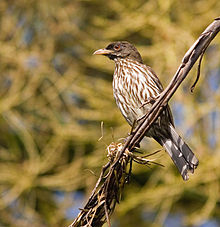- Palmchat
-
Palmchat Conservation status Scientific classification Kingdom: Animalia Phylum: Chordata Class: Aves Order: Passeriformes Suborder: Passeri Family: Dulidae
P.L. Sclater, 1862Genus: Dulus
Vieillot, 1816Species: D. dominicus Binomial name Dulus dominicus
(Linnaeus, 1766)The Palmchat (Dulus dominicus) is a small, long-tailed passerine bird, the only species in the genus Dulus and the family Dulidae. It is thought to be related to the waxwings, family Bombycillidae, and is sometimes classified with that group. The name reflects its strong association with palms for feeding, roosting and nesting.
The Palmchat is the national bird of the Dominican Republic.
Contents
Description
Palmchats are about 20 cm (8 in) in length. They are olive-brown above, and cream-buff, heavily streaked with brown, below. Their rumps and the edges of their primary feathers are dark yellow-green. They have strong yellow bills and russet eyes. They lack the soft silky plumage of the waxwings or silky-flycatchers. Adults are alike in appearance; immature birds have dark throats.[1]
Distribution and habitat
The species is endemic to the island of Hispaniola (politically divided between the Dominican Republic and Haiti), including the adjacent Saona and Gonâve Islands, where it is common and widespread. It inhabits areas from sea-level to 1500 m asl where palm savannas can be found, or other open areas with scattered trees. Where its food trees are present, it has adapted well to city parks and gardens.[1]
Behaviour
Palmchats are very sociable birds, often seen in small flocks containing several pairs which will roost closely together with their bodies in contact.
Breeding
The breeding season is mainly from March to June. The birds build large, messy, communal nests of twigs in the crowns of palms (mainly Royal Palms Roystonea sp.). Occasionally, in the absence of palms, other trees or even telephone poles, may be used. The whole nesting structure may be up to 2 m across, containing up to 30 adjoining nests with their own separate chambers and entrances. The females lay clutches of 2-4 thickly spotted, grey-purple eggs.[1]
Food
Palmchats feed on fruits and berries, including those of palms and of the Gumbo-limbo tree, as well as on flowers, especially those of epiphytic orchids.[1]
Voice
They are voluble and noisy birds, with a large repertoire of gurgling and cheeping sounds constantly used in their social behaviour.[1]
Conservation
The Palmchat is a common species within its range of about 75,000 km2 (28,958 sq mi). As it is not approaching the thresholds for the population decline criterion of the IUCN Red List (i.e., declining more than 30% in ten years or three generations), it has been evaluated as being of Least Concern.[2]
References
- ^ a b c d e Animal Life Resource: Palmchat
- ^ IUCN Red List: Palmchat. Accessed 13 March 2008
External links
Categories:- IUCN Red List least concern species
- Passerida
- Genera of birds
- Monotypic bird genera
- West Indian restricted-range endemic bird species
- Higher-level bird taxa restricted to the West Indies
- Birds of the Dominican Republic
- National symbols of the Dominican Republic
- Birds of Haiti
- Animals described in 1766
- Monotypic bird families
Wikimedia Foundation. 2010.


